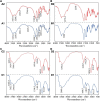Characterization of Different Molecular Size Fractions of Glomalin-Related Soil Protein From Forest Soil and Their Interaction With Phenanthrene
- PMID: 35281310
- PMCID: PMC8905316
- DOI: 10.3389/fmicb.2021.822831
Characterization of Different Molecular Size Fractions of Glomalin-Related Soil Protein From Forest Soil and Their Interaction With Phenanthrene
Abstract
As a natural organic compound secreted by arbuscular mycorrhizal fungi (AMF), glomalin-related soil protein (GRSP) is an important part in soil, affecting the bioavailability of polycyclic aromatic hydrocarbons (PAHs) in it. Previous research have demonstrated that GRSP could enhance the availability of PAHs in the soil and favor their accumulation in plant roots. However, a scarcity of research exists on the different molecular weights of GRSP interacting with PAHs due to their complexation and heterogeneity. In this research, the extracted GRSP in soil was divided into three molecular weight (Mw) fractions of GRSP (<3,000, 3,000-10,000, and >10,000 Da), whose characteristics and binding capacity of PAHs were conducted by using UV-visible absorption, quenching fluorometry and, Fourier transform infrared spectroscopy. The results showed that the GRSP was composed of abundant compounds, it has a wide distribution of molecular weight, and the >10,000 Da Mw fraction was dominant. For three Mw fractions of GRSP, they have some difference in spectral features, for example, the >10,000 Da fraction showed higher dissolved organic carbon (DOC) contents, more phenolic hydroxyl groups, and stronger UV adsorption capacity than the low and middle Mw fractions. In addition, the interaction between GRSP and phenanthrene is related to the characteristics of the Mw fractions, especially the phenolic hydroxyl group, which has a significantly positive correlation with a binding coefficient of K A (k = 0.992, p < 0.01). Simultaneously, hydrophobic, NH-π, and H-bound also played roles in the complexation of phenanthrene with GRSP. These findings suggested that different GRSP Mw fractions could influence the fate, availability, and toxicity of PAHs in soil by their interaction.
Keywords: association coefficient; glomalin-related soil protein (GRSP); molecular weight; phenanthrene; spectroscopic characterization.
Copyright © 2022 Zhou, Wang, Jiang, Leng, Vasilyeva, Waigi and Gao.
Conflict of interest statement
The authors declare that the research was conducted in the absence of any commercial or financial relationships that could be construed as a potential conflict of interest.
Figures




Similar articles
-
Glomalin-related soil protein influences the accumulation of polycyclic aromatic hydrocarbons by plant roots.Sci Total Environ. 2018 Dec 10;644:465-473. doi: 10.1016/j.scitotenv.2018.06.370. Epub 2018 Jul 11. Sci Total Environ. 2018. PMID: 29981996
-
Glomalin-related soil protein reduces the sorption of polycyclic aromatic hydrocarbons by soils.Chemosphere. 2020 Dec;260:127603. doi: 10.1016/j.chemosphere.2020.127603. Epub 2020 Jul 11. Chemosphere. 2020. PMID: 32682136
-
Potential interaction mechanisms between PAHs and glomalin related-soil protein (GRSP).Chemosphere. 2023 Oct;337:139287. doi: 10.1016/j.chemosphere.2023.139287. Epub 2023 Jun 23. Chemosphere. 2023. PMID: 37356591
-
[Distribution and environmental function of glomalin-related soil protein: A review].Ying Yong Sheng Tai Xue Bao. 2016 Feb;27(2):634-42. Ying Yong Sheng Tai Xue Bao. 2016. PMID: 27396140 Review. Chinese.
-
Glycoproteins of arbuscular mycorrhiza for soil carbon sequestration: Review of mechanisms and controls.Sci Total Environ. 2022 Feb 1;806(Pt 2):150571. doi: 10.1016/j.scitotenv.2021.150571. Epub 2021 Sep 25. Sci Total Environ. 2022. PMID: 34582853 Review.
Cited by
-
Soil-Easily Extractable Glomalin: An Innovative Approach to Deciphering Its Molecular Composition under the Influence of Seasonality, Vegetation Cover, and Wildfire.Environ Sci Technol. 2024 Dec 24;58(51):22624-22634. doi: 10.1021/acs.est.4c10036. Epub 2024 Dec 9. Environ Sci Technol. 2024. PMID: 39652190 Free PMC article.
References
-
- Bolliger A., Nalla A., Magid J., de Neergaard A., Nalla A. D., Bog-Hansen T. C. (2008). Re-examining the glomalin-purity of glomalin-related soil protein fractions through immunochemical, lectin-affinity and soil labelling experiments. Soil Biol. Biochem. 40 887–893.
-
- Borie F., Rubio R., Rouanet J. L., Morales A., Borie G., Rojas C. (2006). Effects of tillage systems on soil characteristics, glomalin and mycorrhizal propagules in a Chilean Ultisol. Soil Tillage Res. 88 253–261. 10.1016/j.still.2005.06.004 - DOI
LinkOut - more resources
Full Text Sources
Research Materials
Miscellaneous

